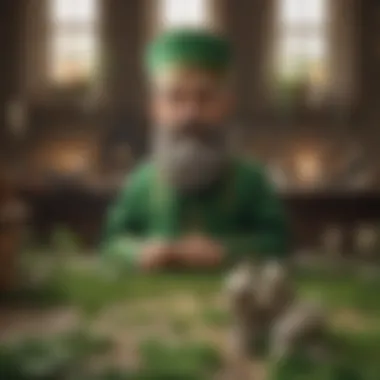The Engaging Tale of St. Patrick for Preschoolers


Intro
The story of St. Patrick is very special. It teaches children about kindness and bravery. St. Patrick is an important figure in Irish history. Every year, people celebrate him on March 17th. This day is known as St. Patrick's Day. It is a time for celebrations and fun traditions. We will explore his life and what he did to help others.
Preschoolers will learn about St. Patrick's journey. As a young boy, he faced challenges and showed courage. He helped many people in Ireland find hope and support.
By understanding who St. Patrick was, children can learn important values they can carry into their lives. These history lessons also connect them to community traditions. With this knowledge, young ones can appreciate their own cultural heritage too.
Fun Facts and Trivia
- Did you know? St. Patrick wasn’t from Ireland. He was born in Britain.
- He used a three-leafed plant, called a shamrock, to teach about kindness and caring.
- On St. Patrick's Day, you wear green to show you’re celebrating.
To make learning more fun, parents can share pictures of shamrocks. You can also find videos showing celebrations around the world.
St.
Patrick's Day Traditions
- Wearing Green: Many people, young and old, wear green clothes or hats.
- Parades: Cities host parades filled with music and dancing.
- Food: Some like to enjoy special Irish foods, like Irish stew or soda bread.
Explaining these traditions to kids can spark their interest. Engaging kids in conversations can be helpful in keeping the traditions alive within families.
“St. Patrick helped the people of Ireland in a loving way that still inspires today.”
DIY Nature Activities
Above all, children thrive with hands-on experiences. Here are some activity ideas:
- Make Shamrock Crafts: Use green paper to cut out shamrocks. Children can decorate it with stickers or colors.
- Plant a Clover: For an adventurous exploration, plant clover seeds in a small cup. Watch the plants grow and remember St. Patrick.
- Treasure Hunt: Parents can hide green objects around the house or yard. Kids can search for them, just like they would hunt for leprechaun gold.
Lessons about St. Patrick provide more than just stories. They lead to creativity and self-expression in preschoolers and beyond. These experiences explore their connection with history and family activities.
Wrap Up
Connecting young minds with inspiring stories like St. Patrick's emphasizes the values of kindness and courage. As families celebrate, they pass down traditions and appreciate the share national heritage. Children learn to embrace their own skills and values improving that knowledge through oppressive games of traditional activities.
Preamble to St.
Patrick
Understanding St. Patrick is essential for appreciating the rich cultural and historical heritage of Ireland. This introduction aims to offer a clear and entertaining window into the life of St. Patrick. By learning about St. Patrick, preschoolers can grasp important concepts of kindness, bravery, and cultural identity.
Who Was St.
Patrick?
St. Patrick was a significant figure in history, recognized as the patron saint of Ireland. His life story includes fascinating events and challenges that he overcome. Patrick was originally born in Britain around the year 385 AD. He was taken to Ireland as a young boy and endured years as a captive. This experience taught him resilience, allowing him to grow strong in faith.
Later in life, Patrick felt a calling to return to Ireland. He successfully persuaded many people to convert to Christianity, spreading messages of hope and community. Through his dedication, St. Patrick became an enduring symbol of goodwill and is celebrated every March 17.
The Importance of St.
Patrick's Day
St. Patrick's Day is more than just a holiday. It serves as a celebration of Irish culture and history. This day is filled with various traditional activities that engage communities worldwide. Events often include parades, music, and traditional Irish dishes, allowing everyone to honor the legacy of St. Patrick.
Celebrating this day promotes unity and fosters understanding among individuals from various backgrounds. Children can learn about the history behind it and be part of community gatherings that strengthen connections. The significance of St. Patrick's Day is not just in customs, but also in recognizing the values of kindness and bravery that St. Patrick championed.
To remember St. Patrick not merely as a historical figure but as a beacon of positive values is crucial for preschoolers.
The life of St. Patrick and the celebration of St. Patrick’s Day provide foundational lessons that endure through generations. Encouraging preschoolers to participate in these traditions will enrich their understanding of cultural heritage.
The Early Life of St.


Patrick
The early life of St. Patrick is a crucial part of his story. Understanding this phase helps us realize how his experiences shaped his future and purpose. The challenges he faced at a young age played a significant role in his character development. By focusing on his early years, we can teach children about resilience, hope, and determination.
Born in Britain
St. Patrick was born in Britain around the year 385 AD. His family was not poor, and they had status in society. However, he was not particularly attentive or religious during his youth. This background gave him a glimpse into both comfort and responsibility.
Being in Britain may have offered him security, yet it did not prepare him for the unexpected events to follow. His early life provides context about how he came to value his family's teachings later in his life. It can be illustrated that children learn from their backgrounds, no matter how remarkable or struggles they may be.
Captured and Enslaved
When he was only sixteen, St. Patrick faced a life-changing event. He was captured by raiders and taken to Ireland after being forcibly taken from his home. There, he became a slave and had to tend sheep, which was hard work. This experience was crucial since it forced him to grow and mature quickly. In isolation, he turned to faith and prayer for comfort.
During his time as a captive, he learned things that he would later utilize to help others. He developed strength, faith, and courage. Understanding this part of his life helps children see the importance of inner strength and the power of finding hope in dark times.
St. Patrick often stated that it was during these lonely hours that he found his true calling, deepening his beliefs and preparing for the journey ahead.
The Journey Home
The journey home is a significant chapter in the story of St. Patrick. This phase is vital because it highlights both personal courage and resilience. After enduring years of slavery, St. Patrick’s determination to return reflects the theme of hope and persistence. The experiences he has while attempting to escape shape his identity, and later, his mission in Ireland.
Escape and Return
St. Patrick's escape is a story of bravery. After six years of being a captive in Ireland, he found a way to flee. He dreamt of returning home, and this dream powered him to action. He managed to escape and traveled over 200 miles to find safety.
During his journey back, he relied on faith. St. Patrick believed that God guided his steps and provided for him. When he reached a ship, he finally felt safe. The captain of that ship did not know him but listened to his story. This moment was crucial, and St. Patrick grasped this chance to go home.
His escape teaches us that sometimes, we need to be brave and hold on to our dreams, even when things are tough.
God's Call to Become a Priest
Once safely back in Britain, St. Patrick's life began to change. He felt a strong calling from God. This call inspired him to become a priest. After his years of hardship, he wanted to help others find faith.
This decision was wise and showed his growth. He went on to study for many years to prepare for his role. His later work in Ireland was shaped by this training. He wanted to return not just as an escaped slave but as a leader offering messages of hope. St. Patrick’s transition from captivity to priesthood is an inspiring path of restoration.
- Bravery: It showed courage to leave comfort for a higher calling.
- Purpose: He had a clear aim to spread Christianity.
- Growth: This phase revealed his personal development and strengthened his faith.
The Journey Home symbolizes both physical and spiritual journeys, profoundly shaping his later life.
St.
Patrick in Ireland
St. Patrick's presence in Ireland carries a vital role in the history and culture of the country. His actions and teachings contributed significantly to the belief systems of the Irish people. Teaching lessons about kindness and faith increased the importance of community and acceptance throughout the land. This section highlights two important aspects of St. Patrick's work in Ireland – spreading Christianity and converting the Irish people.
Spreading Christianity
St. Patrick is best known for his role in bringing Christianity to Ireland. He arrived in the country and began to share his faith with the locals. His message emphasized values like love, kindness, and togetherness. Many people were curious about this new belief.
Key Points:
- St. Patrick traveled shows how important dedication and perseverance are in sharing beliefs.
- He often made use of everyday symbols to illustrate his teachings.
- The shamrock became a tool to explain the concept of the Holy Trinity - the Father, the Son, and the Holy Spirit.
Through simple stories and relatable ideas, he made Christianity understandable. His engaging way of teaching helped people find spiritual meaning in life. Many local leaders admired him and helped further the spread of his ideology.
“St. Patrick believed in kindness and showed that simple actions can make a big difference.”
Converting the Irish People
St. Patrick did not just spread Christianity; he also convinced many Irish people to embrace the religion. His enthusiasm captured hearts, which led to a fast-growing number of followers.
Factors Leading to his Success:


- Cultural Respect: St. Patrick respected Irish customs. By acknowledging local traditions, he gained trust.
- Personal Stories: Sharing personal experiences made his message relatable.
- Sports Meetings: By attending gatherings, he shared discussions about faith and morality. Speaking with everyone, from commoners to chieftains allowed his influence to soar.
People started to see St. Patrick not just as a stranger but someone realized of hope and change. As followers grew, churches start to appear throughout the land. This gradual shift shaped the future of Ireland, making it a place where Christian values became deeply rooted
Understanding the work of St. Patrick shapes one’s perception of not only religious practices in Ireland but also the qualities of his character, bringing lessons still valuable today. Through stories passed down generations, the spirit of determination and kindness inspired by St. Patrick remains alive.
The Legend of the Snakes
Understanding the Symbolism
The legend of the snakes is not just a story; it is a meaningful part of St. Patrick's legacy. When people think about snakes in Ireland, they often relate it back to St. Patrick, who is said to have driven all snakes from the island.
But what does this really mean? For many, it symbolizes the eradication of paganism. At the time Saint Patrick began his mission, pagan beliefs were widely practiced in Ireland. Snakes, often viewed as evil in many cultures, represent those old beliefs. When St. Patrick is said to eliminate snakes, it stands for clearing away pagan practices and bringing in Christianity. This is an essential detail to remember since it shows how values can change and grow.
Additionally, discussing the symbolism of snakes gives a chance to for children to think about their own culture as well. They can learn to ask questions like, “What do certain animals mean in my culture?” This understanding can encourage curiosity and respect for other's beliefs.
Cultural Interpretations
In various cultures, snakes have different meanings and stories. Some communities view snakes as symbols of transformation and healing, much the opposite from the Irish perspective. For instance, in certain myths from other cultures, snakes are seen positively; they're connected to rebirth.
In Ireland’s case, they are seen in another light. After saying St. Patrick drove the snakes out, it became a lesson for many. Parents in Ireland may share this story with their kids. They might relate it to local lessons of good over evil.
Overall, it stands as a reminder of how potent stories can uplift or maintain cultures. The religious relevance connected to St. Patrick can demonstrate resilience through storytelling.
Remember, the story of St. Patrick and the snakes is layered, telling bigger stories about faith, culture, and change.
Traditions of St.
Patrick's Day
Traditions are important for Saint Patrick's Day. They connect us to the history and story of St. Patrick while encouraging community celebration. These traditions not only make the day fun but also educate about Irish culture and history.
Wearing Green
Every year on March 17th, people wear green to celebrate St. Patrick's Day. This is more than just a fun color. Wearing green symbolizes and connects to Ireland, often called the
Symbols Associated with St.
Patrick
Symbols hold great meaning, especially on St. Patrick's Day. For preschoolers, these symbols represent fun and learning opportunities. Understanding these symbols helps children connect with St. Patrick's story and Irish culture. This section focuses on two key symbols: the shamrock and the Celtic cross. These symbols enhance awareness and appreciation for tradition.
The Shamrock
The shamrock is a little green plant with three leaves, recognized widely as a St. Patrick's symbol. Legend says that St. Patrick used the shamrock to explain the concept of the Holy Trinity. This is the idea that God exists in three forms: the Father, the Son, and the Holy Spirit.
For preschoolers, the shamrock is more than a teaching tool—it is playful, fun, and catchy. Here are some points regarding the shamrock's significance:
- Representation of Blessing: The shamrock is seen as a sign of good luck. Many believe that carrying one can bring success.
- Irish Heritage: It symbolizes Irish identity. Many wear it on St. Patrick’s Day to show pride in their culture.
- In Nature: It is important to tell children about its three leaves. Some say if one leaf is lucky, having a fourth can mean extra luck!
The shamrock can lead to crafts and activities. Children might enjoy creating shamrock drawings or even finding real shamrocks in the park. This not only teaches them about nature, but also encourages creativity and exploration.
The Celtic Cross
The Celtic cross holds deep historical significance for Irish traditions. It combines a normal cross with a circle around it. Necessarily, each part represents important religious views and cultural connotations.
Talking about the Celtic cross with young learners helps impart its values. Consider these elements:
- Symbol of Faith: The central part of the cross is what St. Patrick promoted—a Christian faith in Ireland.
- Cultural Identity: It also signifies connection to Irish history. This can prompt questions and stories about heritage.
- Artistic Value: Discuss how beautiful Celtic art depicts the cross, blending art and history. You could even try to do simple designs.
The Celtic cross is an example of how different cultures blend into beliefs and values.
By exploring both the shamrock and the Celtic cross, preschoolers can better grasp the deeper meanings behind St. Patrick's Day. Each symbol opens doors to questions and discussions about life, faith, and culture. This educational experience prepares kids not just for this holiday, but for understanding other cultural meanings as they grow.


Lessons from St.
Patrick's Life
St. Patrick's life is not only a storied past but also a valuable source of lessons. These lessons hold relevance for kids ages five to twelve, as they address core values of kindness and forgiveness. With these notions, preschoolers can grasp important concepts that promote good behavior and empathy. Understanding these themes bridges the past with the present and inspires children to adopt positive habits.
Emphasizing Kindness
Kindness is a central theme in St. Patrick's story. He displayed kindness not only through his actions but also through his willingness to help others. Preschoolers can learn how small acts of kindness can make big differences. St. Patrick treated everyone with respect, includung those who did not treat him well.
- Kindness can be helping a friend or sharing toys.
- It also includes using polite words, like "please" and "thank you".
When young ones understand that they can change someone's day with a little kindness, they start to practice it more often. St. Patrick encourages this idea; his life reminds us that kindness is not just a one-time action. It is a lifestyle that benefits both the giver and the receiver. This lesson teaches empathy and promotes friendship within schools and communities.
"A kind heart is a fountain of gladness, making everything in its vicinity freshen into smiles.”
By nurturing kindness, preschoolers can form deeper connections with others and embrace compassionate actions in their daily lives.
The Value of Forgiveness
Forgiveness is as important as kindness. St. Patrick faced many challenges, especially during his captivity. Instead of seeking revenge or holding grudges, he chose to forgive his captors. This message empowers children by showing that forgiving others allows them to move on from negative feelings and conflicts.
- Forgiveness involves letting go of anger.
- It helps to heal wounds caused by others’ actions.
Teaching preschoolers about forgiveness can foster a more harmonious environment, whether at home or school. When children understand that everyone makes mistakes occasionally, they become more tolerating and supportive of their peers and family members.
St. Patrick exemplified forgiveness as he forgave those who wronged him. His ability to do this not only celebrates the spirit of understanding but also teaches kids a key lesson – everyone deserves a second chance.
Thus, St. Patrick's inspired virtues of kindness and forgiveness create vibrant ideals that impact children positively, nurturing the goodness in their hearts and actions.
St.
Patrick's Contribution to Culture
St. Patrick's role in culture extends beyond mere celebration on March 17th. His life and work significantly shaped Irish identity, religion, and artistry. Children and adults alike can learn valuable insights from his story that underscore kindness and perseverance. This section discusses how St. Patrick's contributions have influenced artistic expression and current traditions in Ireland.
Influence on Art and Literature
St. Patrick’s life ignited a creative spark across generations. His story has inspired countless works of art and literature. Artists portray his experiences through paintings, sculptures, and more, showcasing symbols like the shamrock.
- Literary Works: Numerous writings recall his journeys and miracles. Some notable books include "The Confessio," where St. Patrick shares his thoughts and life lessons. Poems, songs, and folklore emerged, expressing respect for his religious teachings.
- Artistic Representation: Various art forms celebrate St. Patrick. You can find images that depict him driving the snakes from Ireland. Others show him blessing the Irish faithful. These artistic interpretations keep his spirit alive.
St. Patrick serves as a reminder that creativity intertwines with history and culture. As children learn about him, they also encounter literature and art that brings the past to life.
Legacy in Modern Ireland
In contemporary Ireland, St. Patrick is not simply a mythological figure. He is a cultural symbol that influences festivals and celebrations worldwide. His legacy can be seen in the very fabric of Irish society today.
- Celebrations: St. Patrick's Day events include parades, music, and dancing. People wear green and attend local festivities, celebrating Irish pride. These gatherings affirm St. Patrick's enduring influence.
- Education: Schools teach students about St. Patrick, enlightening the next generation. Curriculums include topics on empathy, leadership, and cultural awareness modeled by his life.
- Global Influence: Patriots of Irish descent around the world mark the day, recognizing their shared history. Cities like New York and Boston showcase massive parades that reflect immigrant heritage historia.
St. Patrick continues to be a unifying figure in Ireland. His lessons in bravery and kindness are important both in history and today.
St. Patrick's life cannot be understated. His imprint on art, literature, and community illustrates a deep cultural connection that remains relevant. Children learning about his significance cultivates appreciation not just for traditions but for the rich culture he helped establish.
Epilogue
The conclusion of this article serves a vital role in summarizing the journey through the story of St. Patrick. By reflecting on his impact, children can better understand how one person's determination and kindness can leave a lasting mark on a culture. St. Patrick's life offers several lessons about bravery, forgiveness, and the value of helping others. These themes can resonate well with young minds and help instill moral values in them.
Reflecting on St.
Patrick's Impact
St. Patrick is more than just an Irish symbol. He represents the power of change through kindness. He moved to Ireland and shared his beliefs without force. This act of bravery taught many about compassion and hope. For preschoolers, learning about St. Patrick can inspire them to be brave in their own lives. Understanding that one individual can influence many is a valuable lesson. It opens discussions about why kindness is important in daily life.
By learning about St. Patrick, children not only grasp his story but also recognize how small actions can create greater change in their surroundings.
Encouraging Exploration of Irish Culture
Exploring the life of St. Patrick is an entry point into the rich Irish culture. Traditions like St. Patrick's Day celebrations showcase music, food, and dances that can be quite exciting. Topics like the shamrock and other symbols can spark children’s curiosity about where they come from. Learning about different cultures widens a child’s worldview. It opens their mind to accept diversity and recognize beauty in heritage.
Activities connected to Irish culture facilitate a learning experience. For example, storytelling about Irish folklore can allow children to engage deeply. They may also try making Irish foods, promoting cultural appreciation.







